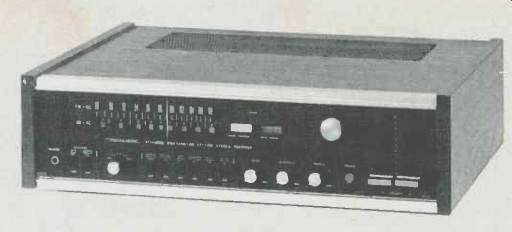
MANUFACTURER'S SPECIFICATIONS
FM SECTION.
IHF Sensitivity: 2 uV
S/N: 65 dB. Image Rejection: 75 dB.
Stereo FM Separation: 35 dB @ 1 kHz
AM SECTION.
Sensitivity: 40 uV. S/N: 50 dB.
Image Rejection: 80 dB.
AMPLIFIER SECTION.
Power Output: 40 Watts rms per channel, 8 ohm loads.
THD: Under 1.0% at rated output. Frequency Response: 20 to 25,000 Hz u1 dB. Phono Sensitivity: 2 mV (low setting); 5 mV (high setting).
Hum: Phono, -65 dB
Tone Control Range: Bass, µ12 dB @ 100 Hz; mid range, µ6 dB @ 1500 Hz; treble, µ12 dB @ 10 kHz.
GENERAL.
Dimensions: 19 3/8 in. W, 5 3/8 in. H, 15 3/8 in. D.
Shipping Weight: 36 lbs.
Price: $299.95.
The front panel of this receiver is an aluminum extrusion with an anodized black center and brushed top and bottom strips. Controls, which can be seen in the photo, include a selector switch, bass, treble and mid-range tone controls (each operating for both channels simultaneously), a good sized tuning knob (with effective flywheel action) and two slide controls for left- and right-channel volume adjustment.
By gripping the two slide controls simultaneously with thumb and forefinger we found that we could maintain good channel balance at all level settings even in the absence of a conventional balance control. A separate push-push power on/off switch can be seen adjacent to the volume controls.
In addition there are eight "piano key" switches for such functions as speaker selection, stereo/mono mode, tape monitoring, AFC on/off, loudness on/off' and low and high frequency filters on/off. The dial scale area includes two meters (center of channel and signal strength) as well as the usual stereo indicator light which lights up when you are tuned to a stereo station. One of the positions of the selector switch is for stereo FM only-allowing reception of stereo stations and acting as a form of muting circuit between stations. If you are seeking mono stations, however, there is no provision for interstation muting in the regular FM setting of the selector switch. At the extreme left of the panel is a stereo phone jack.
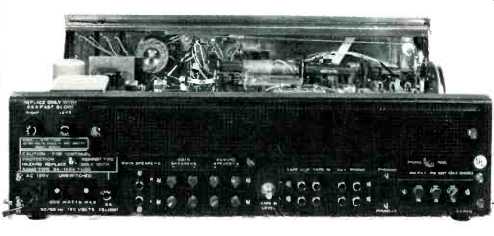
Fig. 1--View of back panel.
The rear panel of the STA-120B is shown in Fig. 1. Speaker terminals are widely spaced and are of the knurled screw type making speaker connection quite easy. There are the usual input jacks for AUX and PHONO, with a slide switch associated with the PHONO inputs for selecting the 2 mV or 5 mV preamplifier input sensitivity. FM antenna terminals are for 300 ohm connection, and there is a terminal for external AM connection, if required. A tape input level control enables the user to set up tape playback level to match that of FM or AM. A pair of phono-tip jacks wired in parallel with the main speaker terminals enable you to connect speaker systems having their own plugs attached. A pair of speaker fuses, a main line fuse, and a convenience outlet (unswitched) plus a ground terminal for connection to record changer or turntable ground complete the back panel layout.
Circuitry

Fig. 1--Internal view.
A view of the top surface of the chassis is shown in Fig. 2. There are nine basic modules used in its construction, including a sealed FM front-end which contains three FET's and a bi-polar transistor. The variable capacitor contains four tuning sections and is completely separate from the three gang AM variable capacitor seen in the photo. The two are coupled together mechanically. The i.f. section includes three high-gain IC stages, a conventional ratio-detector circuit plus four other input and output stages using four additional NPN devices. Two-transistor preamplifier equalizer circuits are used in each channel. The usual treble and bass controls are in a feedback Baxandall arrangement, while the midrange tone control (similar in action to a "presence" control) utilizes a "losser" circuit. Output stages are "push-pull single ended" requiring output coupling capacitors (1000 µF are used) but since the drivers are arranged in complementary symmetry, no interstage transformers are required. The physical arrangement of the modules is orderly and interconnection wiring was found to be of high quality workmanship, with good access to all sections for servicing.
Electrical Measurements
Monophonic FM performance is depicted in the curves of Fig. 3. IHF sensitivity measured 2.5 µV as opposed to the 2.0 µV claimed. Ultimate signal-to-noise was 62 dB as opposed to the 65 dB claimed. This in itself is not a significant discrepancy but we must point out that this figure was obtained only with the bass control turned fully counterclockwise. In its "flat" setting, the hum content was greater than the residual noise so that a new reading of something under 58 dB was all we could get. Aurally, however, this is not disturbing since the low frequency hum at-58 dB is not as audible as wideband noise would be at the same absolute "dB" readings. Ultimate THD in mono was just under 1%.
Stereo FM separation measured just under 30 dB at I kHz, tapering off to 15 dB at 10 kHz on the high end and down to about 20 dB at 50 Hz at the low end, as shown in Fig. 4.
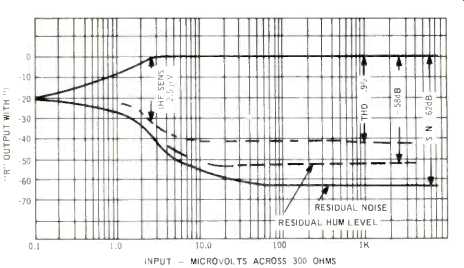
Fig. 3-Mono FM performance.
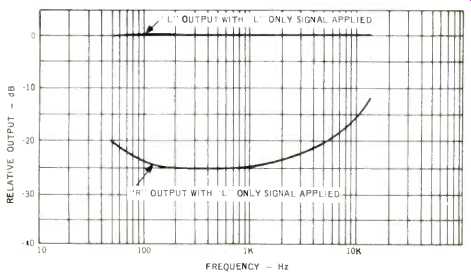
Fig. 4-Stereo FM separation.
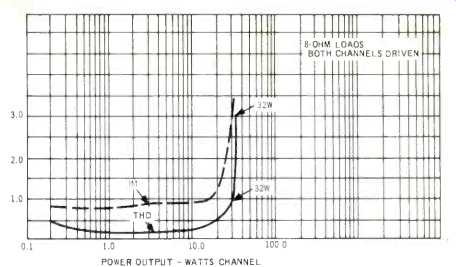
Fig. 5-THD and IM characteristics.
In keeping with our usual practice, we measured power output with both channels driven into 8 ohm loads and came up with a figure of 32 watts per channel at the rated THD of 1%, as can be seen in Fig. 5. At normal listening levels, THD hovered around the 0.2% mark. IM distortion reaches 1% at about 18 watts per channel and at 32 watts, it measured 3.0%. This characteristic is also plotted in Fig. 5. Power bandwidth extends from 18 Hz to 20 kHz, based upon the half-power point referenced from 32 watts. THD at levels of I watt, 16 watts, and full power output for all audible frequencies is plotted in Fig. 6. Square wave response, measured at nominal 1 watt level for 40 Hz and 10 kHz square waves, is shown in the photos of Fig. 7.
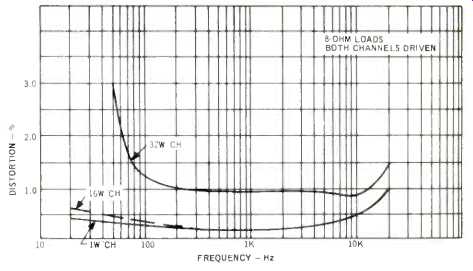
Fig. 6--Distortion versus frequency at various power levels.
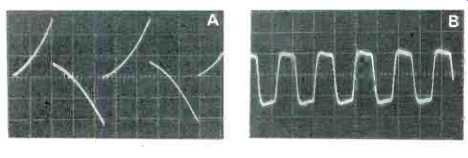
Fig. 7--Square wave response at A, 40 Hz, and B, 10,000 Hz.
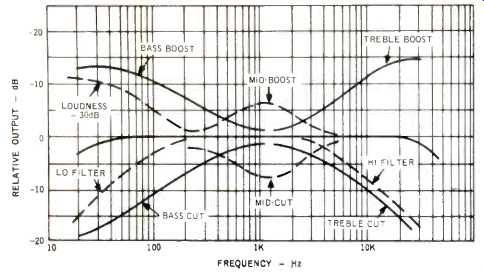
Fig. 8--Tone control, loudness, and filter response.
The action of the tone controls, loudness control, and filters is plotted in Fig. 8. We have always felt that a midrange control (or presence control, if you will) is a nice addition to any amplifier or receiver product if it is executed correctly-and the mid-range control in the STA-120B is perfectly positioned in the frequency spectrum and moderate enough in its effect to be useful rather than overpowering.
There is little or no interaction between it and the more conventional bass and treble controls, all three of which afford the listener a good opportunity to really "tailor" the tonal compensation to meet individual taste. All the tone controls, by the way, have a mechanical detent notch which enable the user to find the mid- or flat-position readily.
Unfortunately, when the bass control was set in the notch, response was down about 3 dB at 20 Hz and we had to re-set it at about 1:30 o'clock for truly flat response, electrically speaking.
The phono preamp sections are very well designed and our hum measurement was actually better than the 65 dB claimed (which in itself would be an excellent number), reading about 68 dB. Bear in mind that this measurement was made in the "2 mV sensitivity" setting of the phono input switch, which makes the reading even more remarkable. Residual hum and noise (volume controls at minimum) is really "way down in the mud," measuring better than -92 dB below full output, and even with volume full up, high-level input noise and hum is down over 75 dB below full power output.
Listening Tests
At moderate to medium-loud listening levels, the Realistic STA-120B provides very clean sound using loudspeakers of relatively low efficiency. If you want to go for the ear shattering kind of sound that seems so popular these days, however, you'll need relatively high-efficiency speakers or else you'll hear that bottom begin to break up at such levels--particularly if you try to boost the bass to unrealistic levels.
FM reception was judged to be quite good for a product in this price range. We logged 40 usable signals with our outdoor Yagi, of which 19 were "stereo-listenable." The stereo-only setting of the selector is very effective and narry a mono signal was able to sneak through when we set 'the switch to that position. The flexibility of the speaker switching arrangement (separate switches for main and remote, unrelated to the headphone jack) is also a welcome feature that we'd like to see more often.
While unrelated to the actual performance of the unit itself, we do have to quibble with a portion of the owner's manual which states, in part: "The [specifications] are subject to variables unrelated to performance, just as frequency range, the number of transistors or IC's or watts, etc., is totally irrelevant to the end product in terms of sound quality." We feel it is sufficient to point out that this was probably not written by the engineer who designed the unit.
Summing up, the Realistic STA-120B represents good value in the low-to-medium price category of stereo receivers, with good basic design, adequate power for clean sound at medium levels with any speakers, and several features worthy of considerably higher priced equipment.
-Leonard Feldman
(Adaped from Audio magazine, Dec. 1972)
Also see:
Realistic (Radio Shack) Model STA-225 AM/FM Stereo Receiver (Equip. Profile, Dec. 1975)
Scott Model R-376 AM/FM Stereo Receiver (Equip. Profile, June 1977)
= = = =